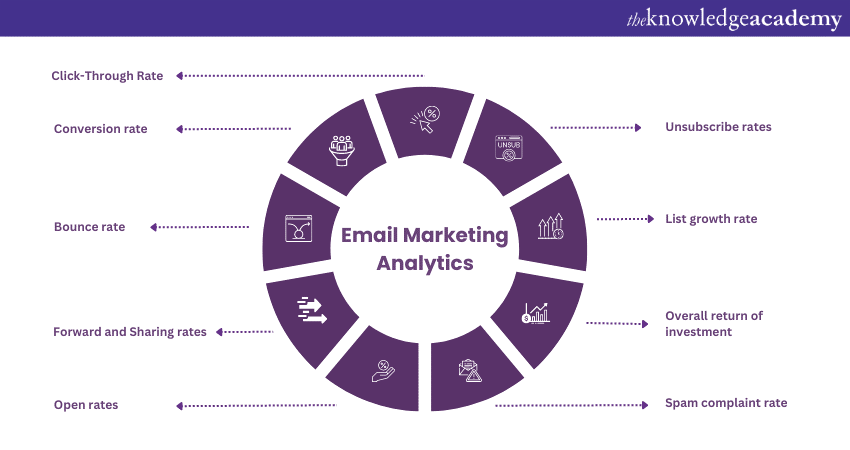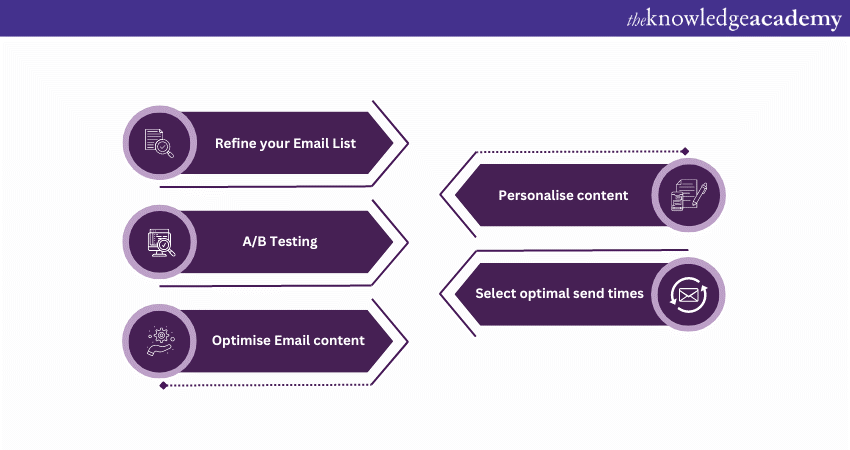We may not have the course you’re looking for. If you enquire or give us a call on 01344203999 and speak to our training experts, we may still be able to help with your training requirements.
We ensure quality, budget-alignment, and timely delivery by our expert instructors.

Email Marketing Analytics remains a significant component of your campaign toolkit despite the abundance of promotional tools available today, and tracking and reporting on it effectively is essential. To exhibit value that supports budgets and shows return on investment (ROI), you as a manager must confirm and even improve how you calculate and track the performance of your email campaigns.
This work is made simple with an appropriate collection of Email Marketing Analytics. You will be able to monitor and report on the true value of your efforts, request more funding, and gain better executive buy-in if you target the correct email marketing key performance indicator.
Table of Content
1) Why Email Marketing Matters?
2) Click-through rate
3) Conversion rate
4) Bounce rate
5) Forward and sharing rates
6) Open rates
7) Unsubscribe rates
8) List growth rate
9) Overall return of investment
10) Spam complaint rate
11) How to improve your email marketing performance?
12) Conclusion
Why Email Marketing Matters?
Email marketing, despite its age, remains a powerful tool for connecting with your audience. However, sending out emails blindly without understanding their impact is a missed opportunity to refine your campaigns and achieve optimal results. This is where email marketing analytics come into play.

Click-through Rate
The percentage of receivers who clicked on a link inside a specific email is known as the click-through rate (CTR), a marketing metric for emails. One of the most crucial metrics, it shows how interesting and pertinent your emails are. To improve this metric, it’s essential to continuously enhance your email marketing skills through testing and optimizing your campaigns.
For instance, if 100 people receive your email but only 10 of them click on a link, something is clearly off with your audience. However, a poor click-through rate may not indicate that your communications are utterly pointless.
Try a few low-cost CTR-boosting tactics before giving up on the campaign. To get recipients to click through to what you send, try including links throughout the email, personalizing the content, or even sending fewer emails with more pertinent content.
The number of subscribers in your email marketing list who have clicked on at least one link is used to compute the email CTR. The number of persons that clicked on your email campaign divided by the total number of emails you sent is the email click-through rate. Then, to display a percentage, multiply that amount by 100.
Explore comprehensive Market Training to ensure you are equipped with the knowledge of marketing fundamentals!
Conversion Rate
A conversion in digital marketing happens when a user completes an intended task or objective on a website, online application, or other digital platform. This can be a specific action, like making a purchase or submitting a form, or a metric, such the number of return visits over a certain amount of time.
How well you turn traffic into income is determined by your conversion rate. It demonstrates how successfully a brand converts visits to sales using its online platform. This is an important marketing metric.
The type of business and industry, primary business goals, brand, consumer group, objectives, season, new product launches, marketing initiatives, and other variables all affect conversion rates. Deciding how you want to proceed is crucial.
Segmenting your intended audience, designing compelling call-to-actions (CTA), doing A/B tests, and employing a straightforward template are all Conversion Rate Optimisation Tips you can use to increase the conversion rates of marketing emails. You can refine your plan and observe higher conversion rates as you cater to the tastes of the target audience.
Bounce Rate
A website's or app's bounce rate is the proportion of users who access one page or piece of content before leaving. The bounce rate delivers overall value and is most advantageous when used as a starting point for assessing how well an email campaign is connecting with audiences when viewed with other facts and data and within the context of what success looks like for your organization.
Emails can bounce for a variety of reasons, including when the email server is down, the receiver's email account is inactive or no longer exists, the recipient's inbox is full, or the recipient has blocked you. However, concentrating on the reason is not the goal. Instead, you should concentrate on decreasing your overall bounce rate.
You should take several steps to reduce bounce rates and raise the success of your email campaigns. To ensure that you are only adding people to your list who want to be there, try techniques like double opt-ins and a sign-up form with captcha. Additionally, you should take care of your email list by routinely cleaning, segmenting, and eliminating hard-bounced email addresses.
Visits to a particular page divided by entries, or the total number of visitors who arrived at the website via that landing page, is how the bounce rate is calculated.
Forward and Sharing Rates
This indicator focuses on the proportion of users that forwarded or shared an email using the "forward" or "share this" button. Since your recipients are already on your mailing list, it is crucial to know how often they forward or share your emails because this can help you find new connections.
Making customised emails is the first step you should take to increase forwarding and sharing rates. Personalized emails are forwarded significantly more frequently than generic emails. Make sure your email content is naturally shareable, something helpful, interesting, or related to an event that your receivers would be encouraged to forward, in addition to adding a clear CTA to forward in it.
By dividing the total number of forwards or shares by the total number of emails delivered, you may find the email forward and sharing rate. You may determine the percentage by multiplying that amount by a hundred.
Open Rates
An email open rate is a means to compare the quantity of emails you send during a certain campaign period to the frequency at which audiences open marketing emails. The email open rate becomes a crucial indicator for assessing the success of your email marketing campaigns when you send marketing materials and advertising to clients and leads on your email lists.
Open rates offer a good indicator of involvement over time, although not being entirely accurate. You will know you need to review your sending frequency and content if you notice a decline in the number of opens, for instance. Too many or too few campaigns sent out at once are two common causes of poor or declining open rates.
Try using a test-and-see strategy to increase open rates. Target a few various factors, such as the time of day the email is sent, the subject line types, and the image usage. Then, compile some illustrative data from your experiment to guide the direction of your email marketing.
It can be challenging to estimate how many emails in a campaign were opened. One of two events must occur for an email to be considered to have been opened:
a) You must grant image viewing permission to your recipient. This is so that it can be tracked if an email has been opened or not. Most email marketing software platforms embed pixels in emails to do this.
b) The email contains a link that must be clicked.
The email open rate is an estimate rather than a precise number because these two factors are outside of your control.
Unsubscribe Rates
The process when a recipient decides to remove their name from a mailing list is called unsubscribed. Therefore, an email unsubscribe rate is the proportion of email addresses, out of all email addresses that successfully received an email, that unsubscribe from an email marketing campaign.
Because the unsubscribe rate affects email deliverability, a high unsubscribe rate will have negative effects on email service providers like Gmail, Yahoo, and Outlook.
A high unsubscribe rate points to weaknesses in your approach and necessitates a closer examination of your email campaigns. It's possible that your audience is not being reached by your content or template choices, or that your sending volume is too high.
By allowing subscribers to choose how frequently they receive emails, soliciting comments, and creating mobile-friendly emails, you can decrease the amount of unsubscribes.
To calculate unsubscribe rates, one must be aware of the number of emails delivered and the number of unsubscribes. It can be calculated using the formula number of unsubscribes divided by the number of successful email deliveries multiplied by a hundred.
List Growth Rate
A key performance indicator called list growth rate tracks how quickly your email list is expanding or contracting over time. It is crucial because it gives your insight into why some techniques or distribution channels are more effective than others, which aids in measuring the effectiveness of your lead capture initiatives. When you have this knowledge, you can modify your entire plan as necessary.
By keeping an eye on your list deterioration, you can increase your list growth rate. If you notice that your lists are deteriorating more quickly than they are expanding, you may want to be more aggressive in tracking the issue to identify the root of the issues.
Additionally, you may consider launching more lead-capture efforts. Putting a restriction on some of your most popularly downloaded or visited content can help you increase your number of subscribers.
You must know your total contacts, unsubscribe rates, and new subscriber rates to determine your list growth rate.
Overall Return of Investment
The return you get overall on your email marketing campaign investment is known as return of investment (ROI). Despite claims that email marketing is outdated in comparison to social media and apps, email marketing is still popular and effective.
Understanding your email marketing campaign's overall return on investment is important since it enables you to determine if it is proving to be a profitable approach or simply a drain on your company's resources.
It is crucial to determine which goal you're measuring so you can utilize the proper metrics and acquire the right data because email marketing is such a flexible technique that can help you reach a variety of unique goals, like lead nurturing, brand exposure, and increasing website traffic.
Your email marketing campaign's ROI can be increased in a variety of ways. For instance, spending money on email marketing automation enables you to adjust your strategy frequently so that you may contact a huge number of individuals at the appropriate moment.
During this time, concentrate on creating highly focused targeted lists which can ensure success rate when you send across content as effectively as possible.
Spam Complaint Rate
The percentage of recipients that flag your email spam out of all the messages you have sent is known as the spam complaint rate. The “this is spam” button can be found in contacts’ inboxes, or contacts can choose to unsubscribe from emails by clicking the default link and specifying it as spam.
Major inbox provider like Gmail have established the accepted industry standard spam complaint rate of one for every thousand messages sent. Anything above this is seen as being high.
The spam complaint rate is crucial since it provides a precise indication of how well your campaign’s sending performed. Given the volume of spam complaints, it is likely that the email receivers did not comprehend or did not believe in it.
Do not employ co-registration, third parties, or trade lists in order to lower your spam-compliant rate. Make sure your emails have the same branding and are sent from the same domain as the ones where subscribers joined up from your list.
Make sure your campaigns “from” name closely matches the branding on the page where contacts signed up. Along with this, avoid sending batch-and-blast email campaigns to sizeable lists and instead, deliver pertinent, tailored, automated messages.
How to improve your email marketing performance?

You need to consider your email campaigns as a whole to determine which metrics to employ. Prioritise your major and minor email marketing goals first. Is conversion one of your goals? Generating leads? For these you will have probably more than one targets. The most important thing is to list them all in an order and prioritise them to achieve your metrics strategy.
Now that you are aware of the email marketing indicators to monitor for continued success and growth, let's look at some specific strategies for improving performance.
To keep your subscriber data, correct and up-to-date, regularly clean it. When possible, avoid those annoying email bounces. Keep abreast on topics relating to data privacy for marketers. Segment your subscription lists to ensure that you are engaging with your audience in the most effective and relevant ways possible.
Make intriguing, succinct content. Be aware of the needs and wants of your target audience. Try to engage people in a way that is valuable to them, and don't forget to be personalized! Do not spam. Be careful how you utilize words, attachments, formatting, and pictures. Avoid using caps lock and exclamation marks!
Analytics give you a platform to accomplish your objectives and enhance your performance, from split testing subject lines, Call to action (CTA) buttons, and design components to monitoring shares and click-throughs. Continue to test and develop. Utilize pertinent email marketing analytics to evaluate the effectiveness of your preheader text and subject lines.
Conclusion
For your campaigns, Email Marketing Analytics are essential. They aid in your ability to comprehend the value of your email marketing and determine whether your strategy is succeeding in achieving your targeted objectives. Therefore, it's crucial to pick your email marketing metrics wisely and to pay great attention to them.
You are well on your way to decide what you want to measure and how to make sure those metrics are precise and pertinent to this list of key performance indicators.
Frequently Asked Questions
Upcoming Digital Marketing Resources Batches & Dates
Date
 Email Marketing Course
Email Marketing Course
Fri 4th Apr 2025
Fri 6th Jun 2025
Fri 8th Aug 2025
Fri 3rd Oct 2025
Fri 5th Dec 2025






 Top Rated Course
Top Rated Course



 If you wish to make any changes to your course, please
If you wish to make any changes to your course, please


